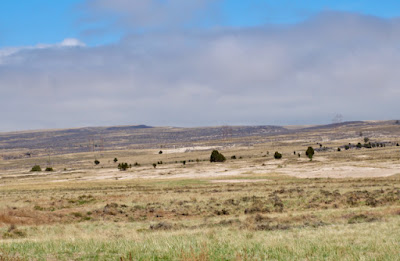 |
| Mid-photo are the two Rocky Mountain Junipers I'm following, at the base of the Laramie Mountains. |
 |
| The approach was not a problem. |
 |
| Photo at highest shutter speed allowed. |
Even after wandering out here all these years, I'm still impressed and astonished that plants can become established and survive in a tiny crevice or depression in bare rock, exposed to the desiccating Wyoming wind. I wonder how old this one is?
 |
| The leaves are covered in silky hairs. |
The scientific name of this plant is Tetraneuris acaulis (Pursh) Greene var. caespitosa A. Nels. There's an interesting bit of history encoded here. F.T. Pursh was the first to name the species (Gaillardia acaulis), in 1814. Then in 1898, E.L. Green moved it to the genus Tetraneuris. In the meantime our very own Aven Nelson, Father of Wyoming Botany, found populations in the Laramie area that were different enough to be be recognized as a new variety. "Its matted habit, silky-lanate leaves and very short scapes [flowering stems] easily separate it." he wrote in 1899. Nelson's 1898 collection from the "Laramie Hills" was the type specimen (basis for description) for the new variety.
 |
| From the Rocky Mountain Herbarium, U. Wyoming. Click image to view labels. |
Zooming in (below), we see this is a member of the daisy or aster family (Asteraceae). What some would interpret as a single flower is actually many tiny ones: a round cluster of disc flowers surrounded by ray flowers with strap-like united petals.
Nelson provided no common name, so I checked the Integrated Taxonomic Information System, supported and used by many North American governmental agencies. Officially, this is the Caespitose Four-nerve Daisy, a translation of the Latin. But there's gotta be something better! I suggest Nelson's Silky Stemless Daisy :)
Sources
Information about taxonomic and nomenclatural history of plant species is available at Tropicos, often with links to historical literature, including the wonderful offerings of the Biodiversity Heritage Library. That's where I found Aven Nelson's 1899 article about the genus Tetraneuris.
This is my rather tangential contribution to news from the tree-followers who gather monthly. More here. Thanks to The Squirrelbasket for continuing to host!


